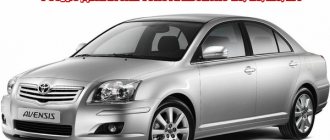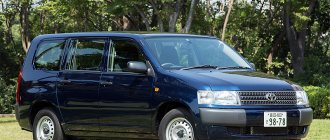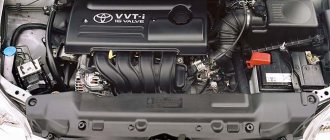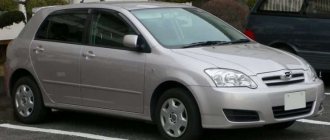The line of Toyota engines labeled ZZ contains two 1.8 liter units. The 2ZZ modification is adapted for high speeds, so the engine has an 82 mm cylinder with a piston stroke of 85 mm. This made it possible to increase power to 192 hp. With.
ICE 1ZZ FE
Conversely, the 1ZZ FE ICE variant produces maximum torque at medium speeds. To achieve this, the cylinder diameter was reduced - 79 mm, but the piston stroke was increased - 91.5 mm. In this version, the manufacturer includes economical fuel consumption and Euro-4 environmental standards.
For the conveyor production of 1ZZ-FE engines, management used the capacity of the TMMC plant in Cambridge (Ontario, Canada). Then the manufacturer had two more versions, the first 1ZZ FED was produced at the Shimoyama plant inside Japan. The second modification, 1ZZ FBE, was assembled in Brazil, used Ethanol E100 biofuel, and was mounted only on Toyota Corolla for the domestic market of this country.
The main feature of the ZZ family of Toyota engines is the aluminum cylinder liner inside an aluminum block. The in-line engine design with DOHC V16 gas distribution is complemented by a fluid coupling for timing distribution on the intake camshaft and a dual and then individual ignition system DIS-2/DIS-4, respectively.
Cylinder block 1ZZ FE
The TRD supercharger was available for two years (2003 and 2004) on Toyota Vibe, Corolla, and Matrix models. The chain drive is used to increase the service life of the timing drive, postponing major repairs by at least 150 thousand mileage. The 1ZZ series has the largest volumes of tent-type combustion chambers.
The absence of hydraulic compensators in the design, on the one hand, reduced the requirements for oil quality, on the other hand, it added manual adjustment of the thermal clearances of the valves every 30,000 km.
Crankshaft design
As a result, the developers received the following technical characteristics of the 1ZZ FE:
| Manufacturer | TMMS |
| Engine brand | 1ZZ FE |
| Years of production | 1998 – 2007 |
| Volume | 1794 cm3 (1.8 l) |
| Power | 88 – 105 kW (120 – 143 hp) |
| Torque moment | 165 – 171 Nm (at 4200 rpm) |
| Weight | 135 kg |
| Compression ratio | 10 |
| Nutrition | injector |
| Motor type | in-line petrol |
| Ignition | DIS-2/DIS-4 |
| Number of cylinders | 4 |
| Location of the first cylinder | TVE |
| Number of valves on each cylinder | 4 |
| Cylinder head material | aluminum alloy |
| Intake manifold | duralumin |
| An exhaust manifold | welded steel |
| Camshaft | original cam profile |
| Cylinder block material | Aluminium alloy |
| Cylinder diameter | 81.5 mm |
| Pistons | narrow skirt |
| Crankshaft | cast iron |
| Piston stroke | 79 mm |
| Fuel | AI-92 |
| Environmental standards | Euro 4 |
| Fuel consumption | highway – 6.2 l/100 km combined cycle 7.7 l/100 km city – 10.3 l/100 km |
| Oil consumption | 0.6 – 1 l/1000 km |
| What kind of oil to pour into the engine by viscosity | 5W30, 10W30 |
| Which engine oil is best by manufacturer | Liqui Moly, LukOil, Rosneft |
| Oil for 1ZZ FE by composition | synthetic in winter, semi-synthetic in summer |
| Engine oil volume | 3.7 l |
| Operating temperature | 95° |
| ICE resource | declared 150,000 km actual 250,000 km |
| Adjustment of valves | mechanical pushers without washers |
| Cooling system | forced, antifreeze |
| Coolant volume | 6.5 l |
| water pump | GWT98A |
| Spark plugs for 1ZZ FE | IFR6T-11 from NGK or SK16R11 |
| Spark plug gap | 1.1 mm |
| Valve train chain | SAT TK-TY124-8 Toyota 13506-22030 (kit) |
| Cylinder operating order | 1-3-4-2 |
| Air filter | Filtron AP142/3 |
| Oil filter | VIC C-110, C-113, DC-01 90915-YZZC7 |
| Flywheel | 3.6 – 3.85 kg (lightweight), steel body, for all types of clutch (ceramics, organics, Kevlar), 00-05 GT |
| Flywheel mounting bolts | M12x1.25 mm, length 26 mm |
| Valve stem seals | manufacturer Goetze, intake gray with NOK mark, exhaust black |
| Compression | from 13 bar, difference in adjacent cylinders maximum 1 bar |
| XX speed | 750 – 800 min-1 |
| Tightening force of threaded connections | spark plug – 13 Nm flywheel – 62 – 87 Nm clutch bolt – 19 – 30 Nm bearing cap – 68 – 84 Nm (main) and 43 – 53 (rod) cylinder head – three stages 20 Nm, 69 – 85 Nm + 90° + 90° |
Due to the alloy block, the manufacturer has improved the driving dynamics of Toyota cars for which the internal combustion engine is intended.
Characteristics
| Power | 120 - 146 hp (88 - 107 kW) |
| Volume | 1796 cc cm. |
| Design | in-line |
| Fuel type | petrol |
| Fuel mixture | Intake manifold/Carburetor injection |
| Supply system | suction device |
| engine's type | petrol |
| timing belt | DOHC |
| Timing drive | Chain |
| Cooling type | liquid |
| Compression | 10 : 1 |
| Piston diameter | 79 mm |
| Piston stroke | 91.5 mm |
| Number of cylinders | 4 |
| Number of crankshaft bearings | 5 |
| Number of valves | 16 |
| Torque | 170 - 172 Nm |
crank mechanism
Due to the increased piston stroke, traction at low speeds is improved and heat loss through the walls of the combustion chamber, which is smaller in size compared to a conventional one, is reduced. But, due to the fact that the piston moves faster than usual, a problem arose with removing oil from the walls, so more serious demands were placed on the rings on the 1ZZ FE series engine.
To make it more compact and reduce friction, the length and diameter of the crankshaft journals were reduced; accordingly, the loads increased and wear accelerated. The crankshaft has a pulley that drives the accessory belt.
The piston skirts are made smaller to also reduce frictional losses, but this has a negative impact on cooling capacity. The pistons were created T-shaped, and they began to knock much earlier when moving to TDC, compared to previous models. The pistons are connected to the connecting rods using floating pins, and the caps are mounted on bolts that are screwed directly into the lower part of the connecting rod.
Modifications
Based on the engine, several variants were produced, differing in power and fuel type:
- the basic FE version, which was produced by the Toyota engine plant located in Buffalo (USA), has a power of 125 to 140 hp;
- The 143-horsepower version of the FED, assembled for the Japanese domestic market, is distinguished by the use of forged connecting rods with reduced weight;
- the FBE modification, adapted to run on biofuel (ethanol), was produced exclusively for the Brazilian market.
The motors were installed on a large number of car models with front-wheel drive and all-wheel drive. There are options designed to work with manual or automatic transmission. In addition, there are engine modifications that remained in production after 2007. Licensed production is carried out by enterprises located in a number of countries in Asia and South America.
Toyota 1ZZ-FE engine tuning
Chip tuning. Atmo
How to properly modify a 1ZZ without turbines and other superchargers, there are not many options, but there are some things... cold air intake, Monkey Wrench Racing Stage 2 camshafts 272, 10mm lift, straight-through exhaust with a 4-2-1 spider, this junk will give up to 30 hp, as well as a more angry and pleasant engine character. There is no point in climbing further.
Turbine on 1ZZ-FE
A turbo kit based on the Garrett GT28 is purchased, with a manifold, midpipe, downpipe, intercooler, blowoff, along with this, 440cc injectors, a Walbro 255 pump, Apexi Power FC brains are taken, we blow 0.5 bar, we get 200 hp. on stock piston. To blow more air, you need to reduce the compression ratio by installing forged connecting rods and pistons under 8.5 compressor, replace the injectors with 550cc/630cc, it wouldn’t hurt to port the cylinder head, cook the exhaust on a 2.5-inch pipe and blow 300+ hp. until it falls apart.
Design Features
1ZZ FE motors in all variants are equipped with a unified aluminum block with an open cooling jacket at the top (open deck design). The block provides only a transverse installation diagram of the unit in the engine compartment. A cast iron casting is poured into the body of the block, forming the cylinder mirrors. The casting has thin walls, which makes it easily deformed when overheated. There is no coolant flow between the walls of adjacent cylinders. Antifreeze moves simultaneously from 2 sides, uniformly cooling the cylinders.
The cylinder head is made of aluminum and has camshafts with a single-row chain drive. The chain tension is adjusted by a hydraulic device powered by a lubrication system. The gas distribution mechanism has a VVTi phase shifter at the inlet.
The valve seats are made using laser deposition technology of carbide material. The small thickness of the layer has a positive effect on heat dissipation, but the design is not suitable for repair. The valve plates received an increased diameter, while the diameter of the rod decreased at the same time. The valve drive uses special clearance compensators of varying thicknesses. The low weight of the valve made it possible to use springs with reduced stiffness and narrow the working surface of the cam.
The combustion chamber has a special shape that promotes swirling of the working mixture near the spark plug electrodes. The piston has a protrusion designed to improve filling of the cylinder and form vortex flows. The design ensures accelerated combustion of the working mixture and reduces the likelihood of detonation.
The crankshaft is mounted on 5 supports equipped with a common cover. In the design of the crank mechanism, a scheme with a long piston stroke (larger than the diameter) was used. Due to this, the torque platen is shifted to low speeds. The lubrication system operates from a cycloid type pump installed in the timing drive. The oil pan is made of aluminum alloy. The installation plane is located on the axis of the main bearings, which increased the rigidity of the structure.
The intake manifold is located closer to the radiator, the exhaust manifold is installed on the side of the engine shield. The catalytic converter is located under the bottom of the car. The intake manifold is made of aluminum alloy and has identical channels for all cylinders. The design of the unit is welded. On later versions of the engine, a plastic manifold began to be used.
The engine uses unleaded gasoline with an octane rating of 95 as fuel; The manufacturer allows long-term operation of the unit on A92 gasoline.
The ignition system on early engines has 2 ignition coils (DIS-2). Later, individual ignition coils began to be used (DIS-4 system).
The attachment is driven by a poly-V-belt equipped with a hydraulic tensioner.
Electronically controlled EFI fuel injection is used. The fuel system does not have a gasoline return line to the tank. The fuel supply pressure is regulated by a special valve located inside the pump. The fuel injectors are installed directly in the cylinder head. To improve mixture formation, nozzles with a large number of holes are used.
Some vehicles supplied for the Japanese market may have had a low capacity TRD supercharger installed. The cars were produced in 2003-04. The modification was carried out by a specialized division of the manufacturer.
How to extend the life of the motor?
As noted above, a lot depends on the driver. Firstly, this is a high-quality lubricant. You should only buy engine oil that is recommended by the manufacturer, or an analogue that has the appropriate approvals. Secondly, it is advisable to change the oil in a timely manner. But you shouldn’t do this every 2-4 thousand kilometers. Under normal operating conditions, the original lubricant lasts about 10 thousand with a slight loss of performance. It is necessary to try to avoid oil starvation, as this can lead to a significant reduction in the life of the internal combustion engine.
Problems in the cooling system can lead to overheating of the Toyota 1ZZ-FE engine. Since the block head is made of aluminum, it can lead. It is better to replace this motor with a contract one. It is advisable to select a gentle operating mode. All kinds of kick-downs have a negative impact on the power unit, so long-term driving at high speeds is best avoided.
Advantages and disadvantages
The advantages of the motor are:
- low fuel consumption;
- good traction achieved by using a phase shifter and motor design;
- durable timing chain drive;
- prevalence, availability of spare parts.
The disadvantages of the 1ZZ series internal combustion engine are:
- low rigidity of the block and head - due to slight overheating, the parts warp and begin to leak oil and antifreeze along the joint line;
- reduction in the width of the crankshaft journals and camshaft cams, which resulted in increased load and accelerated wear;
- poor design of oil scraper rings on early engines, leading to oil consumption;
- the block head does not allow replacing valve seats;
- the small thickness of the liners does not allow boring during repairs; in addition, there are no original piston parts with repair dimensions;
- knocking of the piston skirts on a cold engine - as the parts warm up, they expand and the knocking stops.
Recommendations
- "Toyota engines". Toyoland.com. Retrieved 2012-11-23.
- https://toyotacelicaonline.com/engine.htm Toyota Celica Online - Engine number
- https://papers.sae.org/981087/
- https://www.spyderchat.com/1zzfe.pdf Toyota 1ZZ-FE SAE Technical Document
- https://www.caranddriver.com/news/a15133815/supercharged-trd-matrix-auto-shows/
- “Toyota MR2 2002, 2005 onwards. ZZW30". carfolio.com
. February 28, 2013. Retrieved July 26, 2021. - "车宝骏560,1.8L发动机的前世今生." www.twoeggz.com
. 2017-10-25. - Schaefers, Martin. "(S)GM(W) ENGINES IN CHINA AND ELSEWHERE." Far Eastern automotive literature
. - ^ a b c
“The Next Band Wagons” -
Motor Trend
, Chris Walton. May 2002 - https://www.zeperfs.com/en/fiche367-toyota-corolla-ts.htm
- https://web.archive.org/web/20050509154910/https://motor.terra.es/motor/contactos/c_ficha.cfm?id=MOT21278
- "Lotus Elise R - Description of the car." Lotus PLC Group. Archived from the original on May 17, 2008. Retrieved 2008-06-24.
- Chris Walton (June 28, 2006). "Full Test: 2006 Lotus Exige." Edmunds Inc. Archived from the original on 2008-06-25. Retrieved 2008-06-24.
- Greg N. Brown. "Newcomers: 2007 Lotus Exige S." MotorTrend
. Source Interlink Media, Inc. Retrieved 2008-06-24.
Malfunctions and repairs
Common breakdowns of 1ZZ motors include:
- Increased oil consumption on engines of the first years of production, caused by design defects in oil scraper rings. If the previous owners did not carry out repairs, then upgraded rings should be installed on the pistons. Motors assembled after 2005 are free from this drawback.
- Increased noise level when the engine is running hot and cold. The cause of the extraneous sounds is wear on the tensioner roller bearing for the serpentine belt used to drive attachments. With a mileage of more than 150 thousand km, it is recommended to replace the timing chain. Knocking noise from valve actuators is rare and indicates failure of the clearance compensators.
- Unstable idle speed is a sign of throttle contamination. The problem is solved by cleaning the unit without removing it from the engine.
- Increased engine vibration indicates wear of the power unit support. Repair consists of installing a new part.
Let's sum it up
The Japanese ZZ series engine is definitely worth a look. It is a pity that the developers did not provide for the possibility of a major overhaul, or perhaps deliberately made the design exactly that way in order to improve performance characteristics. One thing is for sure: this motor is not bad and is very popular. Of its design features, only vibrations are worth highlighting. It will not be possible to completely get rid of them; you can only replace the rear mounting cushion for the internal combustion engine, which does not always help solve the problem.
For its time, this power unit had unique performance characteristics. The 1ZZ-FE engine from Japan always means a high level of reliability. Although the development is considered partly American, it uses the DOCH gas distribution system, which was invented in the USA. But all further modifications were developed directly in Japan. In order for the motor to work for a long time and properly, it must be maintained and periodically made minor repairs. It is clear that overheating must be completely eliminated, because this can lead to major repairs. Timely maintenance work is already half the success.
Service
It is recommended to change the oil after 5-6 thousand kilometers (regular - after 10 thousand km). For engines, synthetic oil with a viscosity of 0W-20 is used (substitute is 5W-20). Engine crankcase capacity - 3.7 l; another 0.2 liters is poured into the oil filter housing.
The scheduled period for replacing spark plugs is after 20 thousand km. Long-term use of parts is undesirable, as it leads to failure of the ignition coils.
Adjusting the valves involves selecting pusher cups with the required bottom thickness. The plant produces pushers with small size increments, which allows you to select the required part. The size is indicated on the inner surface of the parts. The frequency of adjustment is every 130-150 thousand kilometers.
VVT-i
Developed by Toyota Corporation, the variable valve timing system - VVT-i - smoothly rotates the camshaft in relation to the drive sprocket depending on the operating mode of the engine. The maximum rotation is 60°. The drive itself is a rotor with blades. Before starting, a special stopper fixes the shaft in the position of the maximum late ignition, to ensure optimal starting conditions.
The electromagnetic valve, at the command of the controller, controls the flow of oil entering the cavities of the mechanism, providing a delay or advance of the phases. The controller, in turn, reads information from sensors that monitor the positions of the camshafts.











